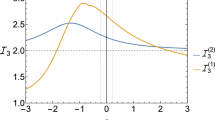Abstract
The existence of heavy mirror analogs of ordinary fermions would provide deeper insight into the gedanken paradox appearing in the Standard Model upon direct parity violation and consisting in a physical distinguishability of left- and right-hand coordinate frames. Arguments are presented in support of the statement that such mirror states may also be involved in the formation of observed properties of the system of Standard Model quarks and leptons—that is, their mass spectra and their weak-mixing matrices: (i) In the case of the involvement of mirror generations, the quark mixing matrix assumes the experimentally observed form. It is determined by the constraints imposed by weak SU(2) symmetry and by the quark-mass hierarchy. (ii) Under the same conditions and upon the involvement of mirror particles, the lepton mixing matrix (neutrino mixing) may become drastically different from its quark analog—the Cabibbo-Kobayashi-Maskawa matrix; that is, it may acquire properties suggested by experimental data. This character of mixing is also indicative of an inverse mass spectrum of Standard Model neutrinos and their Dirac (not Majorana) nature.
Similar content being viewed by others
References
T.D. Lee and C.-N. Yang, Phys. Rev. 102, 290 (1956); 104, 254 (1956).
L. B. Okun, hep-ph/0606202; Phys. Usp. 50, 380 (2007).
C. S. Wu et al., Phys. Rev. 105, 1413 (1957).
J. Maalampi and M. Roos, Phys. Rep. 186, 53 (1990).
S. Chakdar et al., arXiv: 1305.2641 [hep-ph].
I. T. Dyatlov, Phys. At. Nucl. 77, 733 (2014); arXiv: 1312.4339 [hep-ph].
Part. Data Group, Phys. Rev. D 86, 010001 (2012); Chin. Phys. C 38, 090001 (2014).
G. Altarelli, arXiv: 1404.3859 [hep-ph]; L. Maiani, arXiv: 1406.5503 [hep-ph].
H. Fritzsch, Phys. Lett. B 70, 436 (1977); 73, 317 (1978).
C. D. Froggatt, M. Gibson, H. B. Nielsen, and D. J. Smith, hep-ph/9706212; C. D. Froggatt and H. B. Nielsen, hep-ph/9905445.
S. Dimopoulos and L. Susskind, Nucl. Phys. B 155, 237 (1979); S. Dimopolous, Nucl. Phys. B 168, 69 (1980).
R. N. Mohapatra and A. V. Smirnov, hepph/0603118; S. F. King et al., arXiv: 1402.4271 [hep-ph].
L. D. Landau and E. M. Lifshitz, Course of Theoretical Physics, Vol. 3: Quantum Mechanics: Non-Relativistic Theory (Fizmatlit, Moscow, 2004, 6th ed.; Pergamon, New York, 1977, transl. 3rd ed.).
A. J. Buras, arXiv: 0910.1481 [hep-ph]; L. Calibbi, Z. Lalak, S. Pokorski, and R. Ziegler, arXiv: 1204.1275 [hep-ph].
Author information
Authors and Affiliations
Corresponding author
Additional information
Original Russian Text © I.T. Dyatlov, 2015, published in Yadernaya Fizika, 2015, Vol. 78, No. 6, pp. 522–533.
Rights and permissions
About this article
Cite this article
Dyatlov, I.T. Quark and lepton mixing as manifestations of violated mirror symmetry. Phys. Atom. Nuclei 78, 485–496 (2015). https://doi.org/10.1134/S1063778815030047
Received:
Published:
Issue Date:
DOI: https://doi.org/10.1134/S1063778815030047




